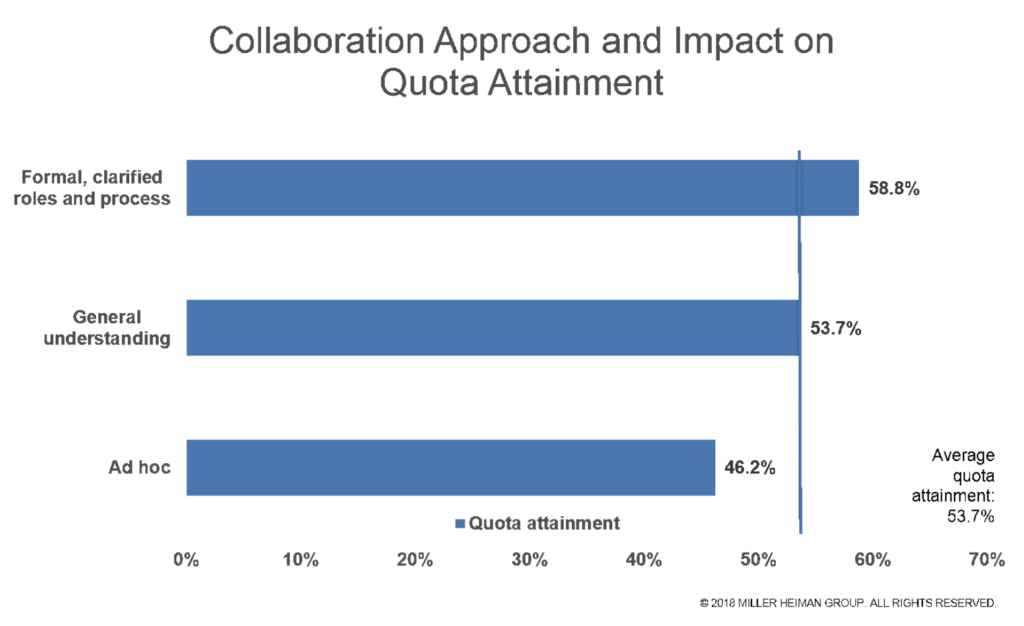Here’s an important, and often overlooked, fact about B2B sales and marketing: Your customer data holds all the keys you need to grow your business.
To succeed, you need to trust the data and step into predictive sales.
It’s not as easy as it sounds, though. Many sales and marketing leaders try to get cute and overthink their targeting, messaging, content creation, etc. I’ve been guilty of this myself, trying to imagine who my buyers might be and what they want to hear — versus letting the data lead my decision making.
This post is a simple walkthrough of the why and the how behind predictive sales and marketing strategies, and why it all starts with your own customer data. Let’s dig into it.
How Customer Success Drives Predictive Sales and Marketing
Today, the best B2B marketers and sales professionals are best because they know what makes a successful customer. They know what their buyer looks like… what his or her pain points are… why they’re buying… and other important details about their overall situation.
Customer experience (CX) and machine learning, together, are likely to be the defining element in B2B marketing and sales strategy in the coming years.
An increased emphasis on customer success will lead savvy companies to link customer data (account info, demographics, and behavioral data) with business data (account spend, renewal rate, etc).
RELATED: Digital Sales Data: The (Real) Secret to Moving Deals from Prospect to Closed
The revelations that emerge from uniting these two sets of data will not just align marketing and sales but all revenue-generating and customer-facing departments.
How does machine learning come into the picture?
The terms, Predictive, Machine Learning, and A.I. may sound expensive, hype-driven, and essentially meaningless to the modern B2B sales and marketing leader, but not so fast. We’re reaching a tipping point in the capabilities and availability of predictive technology in B2B sales and marketing.
The premise: History repeats itself. Past performance is the greatest predictor of future events, whether we’re talking international politics or the success rates for various B2B sales and marketing efforts. If your company is struggling to sell into one industry but is closing at a massive clip in another industry, you can bet that trend will continue.
Unfortunately, in many cases, these trends are hard — if not impossible — for a human to spot and keep up with.
This video on the Future of Sales dives deep into 8 sales strategies that are expected to drive sales.
The tipping point: In B2B, you used to need a massive budget or a committed business intelligence team to get great predictive insights for sales and marketing. That period has come to end. Today, the sophistication and mass availability of data intelligence software means just about any company can have a sophisticated system to do predictive sales analytics.
Building a Foundation for Predictive B2B Sales and Marketing
There are three primary reasons every B2B company should make customer metrics the core of their sales and marketing strategy, with predictive analytics serving as the connector behind past and future success.
We’re going to look at each one, and how you can set it up in your own business.
1. It creates a better customer experience.
Reason #1 for predictive sales is that it makes it easier to create a powerful, positive customer experience.
And that’s the basis behind the wish list for every B2B sales organization:
- More customers
- Higher average contract values
- Negative churn
- High renewal rates
- Increased referrals
- Shorter sales cycles
- Stronger inbound lead generation.
In other words, a better customer experience is the solution to everything that makes life easier for the entirety of your front office.
All those things on the wish list? They’re organic revenue drivers. They’re the true north for sales and marketing in a time where there are, on average, 7 decision-makers in the B2B buying process.
The data behind client success is incredibly powerful. It can point your organization towards ad geo-targeting for marketing, industry verticals for sales, and product road-mapping for developers, to cite just a few examples.
How to Get Started:
The starting point here is data collection. You need three sets of data about your customers to properly understand them:
- Firmographic and technographic data (who they are)
- Pre-Sale Behavioral Data (why they bought)
- Post-Sale Customer Success Data (how happy they are)
RELATED: The Data Points You Need for an Effective Account Targeting Strategy
The first set of data is easy. You just need a data enrichment service like Clearbit, Everstring, or SalesIntel that populates your CRM database with all the information you need about who your buyers are.
The second set of data starts with a marketing automation platform such as Pardot, HubSpot, or Marketo and tracks your buyer’s journey through your marketing and sales funnel.
For added firepower, invest in an attribution platform such as Bizible that shows you every touchpoint your buyer has en route to purchasing your product.
The third set of data requires the help of a good customer success measurement system. Nextiva, for example, tracks every engagement your customer has with your company, from outbound call to support case submission, and scores their overall satisfaction with your platform using sentiment analysis — whether you are at the office or working remotely.
2. It improves targeting, messaging, and [everything].
84% of B2B decision makers start the buying process with a referral. The more you focus effort and attention on customer experience, the better your targeting, your messaging, your marketing collateral — everything.
This is why sales enablement initiatives containing a formal process for cross-functional collaboration are most likely to hit expectations (source).

Database enrichment, predictive analytics, and client communications technology have decimated the silos around CX in many B2B sales organizations. Affordable and integration-ready, these tools are equipping SMB and mid-market B2B companies with insane insights across all functions.
Fully enriched client database? Searchable support channel? Client satisfaction and engagement scores? All are readily accessible to your entire organization.
How to Get Started:
Once you have all your data points about your customer experience, you can reverse-engineer your ideal customer persona and roadmap, creating the one true nexus for your entire company.
Which customers closed the fastest and for the highest dollar values? How did they discover your company and what channels did they come in through?
Which customers are enjoying the most success? Are they in a specific industry or city?
What content are your successful customers and high-converting prospects ingesting pre and post-sale? Are there recurring assets or conversations offering premium value to their success?
The answers to these questions should inform ALL of your future sales, marketing, and customer success activities.
Once you’re aligned on who your ideal customer is, you can draw up customer referral programs aimed at bringing in customers who match your ideal profile.
You can launch new content, directly attacking the problems that lead your ideal customers to your platform.
You can team up with ideal partners, whose clients overlap with yours, to amplify your brand across channels.
All of this starts with mapping your customer experience using data, and creating a composite of your ideal customer and roadmap.
3. It drives long-term growth and prosperity.
If you’re not here to create a positive experience for your customers, good luck achieving long-term growth and prosperity.
The companies that deploy successful B2B sales and marketing initiatives will look first to their existing customer data. Beyond that, successful companies will work aggressively to establish a customer success-based foundation for future revenue growth.
It’s the Digital Age. The information gap between businesses and consumers has all but evaporated.
For the first time in the history of commerce, B2B companies no longer have total control over product messaging — as Brian Halligan and Daniel Pink noted in Hubspot’s initial How to Sell Like a Human interview. Instead, who has the power? Their clientele does — on review sites, message boards, and social media.
Nowadays, the buyer’s journey can begin without any meaningful interaction with your polished marketing campaigns and silver-tongued sales talent.
Your clients define your brand, your value, and ultimately, the potential of your business. In that respect, every organization must make a choice when it comes to customer success.
How to Get Started:
Using predictive analytics and real-time customer data, your B2B company can become smarter about guiding what your customers say about them.
Track metrics that indicate customer satisfaction, and then use these insights to hand your happiest clients a megaphone to sing your praises. This helps you avoid accidentally requesting reviews and referrals from clients looking to take a sickle to your business online.
Use your ideal customer persona and the roadmap you created in Step 2 to guide your marketing and sales efforts. Continuously revisit and refine your personas and processes as your business evolves. This will enable you to keep the machine running and stay ahead of the curve when your competitors start copying your tactics. (Trust me, they will.)
Beyond the Hype: Bringing Predictive to B2B Sales and Marketing
We have reached a tipping point in the B2B sales profession. Customer data enrichment, analytics, and predictive forecasting are more powerful and available than ever before.
Companies with reliable, high-quality customer data and a client-centric focus will be best-suited to activate predictive analytics, machine learning, and AI to accelerate revenue growth dramatically.
Best of luck to your B2B sales and marketing organizations going forward. Get data. Get customer-focused. Get predictive sales…
And get smarter with your sales and marketing initiatives.







